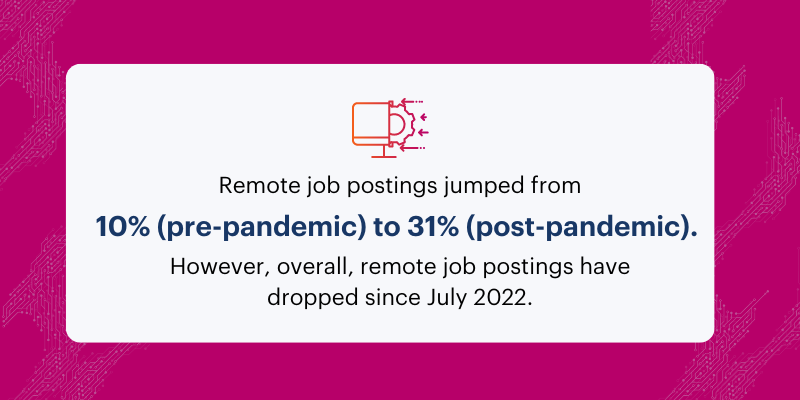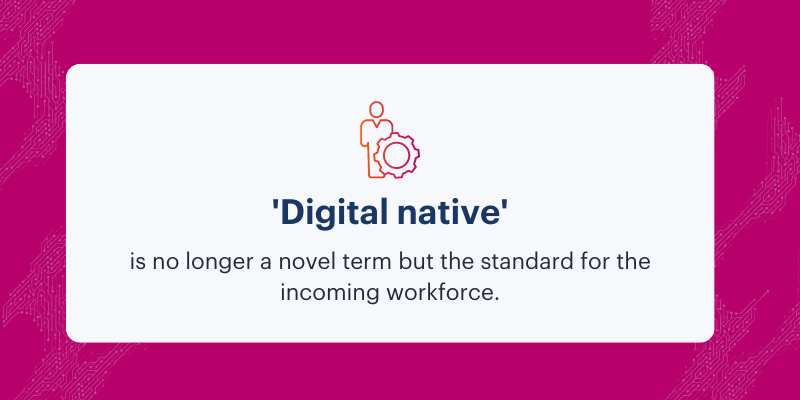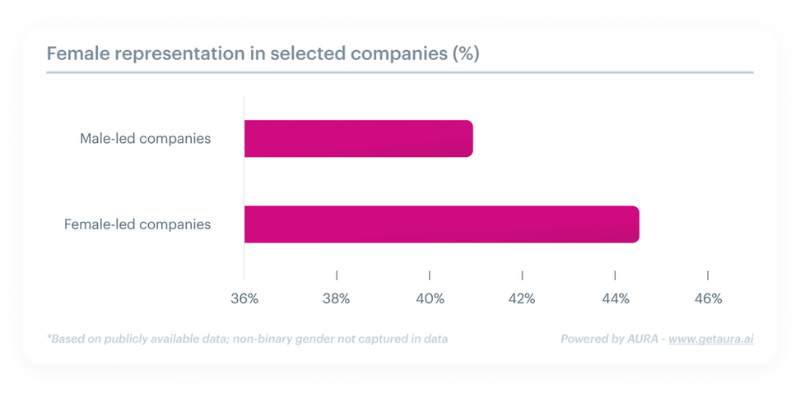Explore Workforce Trends: Insights into a Changing World of Work
At Aura, we closely monitor the leading topics and trends shaping the world of work. Based on our Q4 2023 findings, we've identified intriguing waves on the horizon that will impact workforce intelligence and dynamics in the year ahead.
Want your workforce stay competitive? Book a demo with Aura and explore workforce intelligence solutions tailored to your needs.
Understanding these trends is beneficial and essential for organizations seeking to thrive in the rapidly evolving corporate ecosystem. Our exploration will equip you with the insights needed to make strategic decisions, navigate challenges, and seize opportunities in the face of this changing workforce.
Please continue reading to explore the upcoming workforce intelligence trends for 2024 and gain valuable insights from our proprietary research.
Workforce Demographics: Key Shifts to Watch
As the professional landscape transforms, so does the composition of its players. Let’s look at the significant demographic shift that's set to redefine the workforce.
How Gen Z is Redefining Workforce Dynamics
Gen Z is stepping onto the scene, making waves with their tech-savvy, progressive values and fresh perspectives. Interestingly, The Bureau of Labor Statistics has forecasted in 2024 that for every four workers, one will be aged 55 or older—which is up from 21.7 percent in 2014. This means Gen Z will be coming into the workforce with a significant amount of Gen X coworkers, which will undoubtedly shed light on the importance of intergenerational communication and understanding.
However, it's not just about numbers. ADP confirms the essence of Gen Z integrates digital fluency with a need for meaningful work, inclusivity, and a balance between their professional and personal lives. These are telltale signs of organizational transformations that businesses should anticipate and accommodate. Traditional management strategies aren’t going to engage with this dynamic new cohort.
Knowing these shifts are coming, organizations that proactively embrace change—and seek to understand the diverse motivators and goals of different age groups—will enjoy a distinct advantage.
These new effective strategies hinge on open communication channels. Annual surveys? Not enough. Real-time feedback mechanisms that capture the evolving needs of your workforce will be incredibly valuable. Remember, a one-size-fits-all approach is a recipe for disengagement and turnover in a multigenerational workforce.
Embracing the Gig Economy: Flexibility in a New Era
Alongside Gen Z's rise, the gig economy is noticeably growing, with more professionals opting for freelance and part-time positions. This model offers unprecedented flexibility and autonomy, which aligns particularly well with the preferences emerging from younger generations.
Leveraging the gig economy means a more agile, adaptable talent pool for employers. However, keeping up requires considerable reevaluation of engagement strategies, benefits packages, and long-term workforce planning.
A Strategic Response
A seismic shift is underway, calling on HR teams to use data-backed insights to decode what makes their diverse workforce tick. Smart organizations are already investing in sophisticated analytics tools to predict employee preferences, augment their talent acquisition strategies, and nurture a culture that respects individuality yet fosters unity.
As you go forward, ask yourself: Is your organization equipped to mentor across generations, blend traditional wisdom with Gen Z's zest for tech, and offer the kind of flexibility that can sway a top freelancer to team up with you rather than your competitors?
Skill-Based Hiring: The Future of Talent Acquisition
In a rapidly reshaping landscape around the evolving demands of the modern industry, we're witnessing a pivotal shift where talents may trump titles. The future of hiring is less about the framed credentials on a wall and more about the real-world skills etched into a candidate's repertoire.
Breaking Barriers: Why Skills Matter More Than Degrees
“Paper ceilings,” or professional barriers against people who don’t hold college degrees or some postgraduate degrees, are giving way to a workforce that values results and adaptability over traditional academic achievements. In a world where change is the only constant, individuals who demonstrate critical thinking and problem-solving aptitude emerge as the most treasured assets of forward-thinking companies.
According to data from Aura, MBA-holding employees make up approximately 2% of various sectors. Notably, management consulting boasts 8.3%, banking and finance at 7.3%, and VC/PE takes the lead with an impressive 13.7% of MBA-holding employees. However, these findings only highlight one factor that contributes to career progression and confirm that an MBA is not the sole determinant of success.
It is no longer merely a question of possessing a degree; it's about showcasing a variety of competencies, from technical know-how to the profound depths of emotional intelligence.
The Shift to Skill-Based Hiring
Companies casting their nets increasingly disregard degrees as the default measure of capability. Instead, there’s an emerging trend of hiring practices being honed to scout for specific skill sets aligned with role requirements. This paradigm shift highlights what a candidate can do and achieve rather than their education path.
As we dissect the core competencies vital for future roles, the emphasis on soft skills takes center stage. Communication, teamwork, and emotional intelligence – these are not just buzzwords but the pillars the 2024 workspace stands on.
Expanding Talent Horizons: Cross-Industry and Remote Trends
Fueling this shift, cross-industry competition for talent has escalated. With specialized roles becoming commonplace, the search for skills sees companies poaching talent across various industries. This presents a unique phenomenon: the value of cross-pollination of ideas and disciplines, which fosters innovation and drives growth.
Taking a page from the nuanced playbook of remote work trends, we can appreciate the rich mosaic our workforce is morphing into. While tech giants like Google and Meta hint at a return to office environments, a core group of small—to mid-sized enterprises continue to embrace the remote revolution. These businesses reap the benefits of distributed teams, not just in the considerable savings on physical space but also in the access to untapped global potential.
Remote First, Location Second
The data is telling—a leap from a pre-pandemic 10% to a robust 31% of remote job listings reflects a fundamental shift in the employment landscape. While this data reflects a 3x jump from pre-pandemic levels, it’s also shrunk 10% from the post-pandemic remote job posting peak since July 2022. Yet, while remote-first companies increasingly hire outside major tech hubs, achieving a genuinely decentralized workforce remains a work in progress.

Evidence from companies pioneering the "work from anywhere" model, such as GitLab, exhibits a dispersed employee base—about 80% working outside the top five tech hubs. Such dispersion sharply contrasts to the overall U.S. tech industry's 45%, accentuating the transformative potential of remote-first policies.
Industry Shifts in Workforce Intelligence Trends
The employment landscape is substantially transforming thanks to disruptive technologies and shifts in societal values. As we navigate these changes, it becomes vital for businesses and job seekers to stay ahead of current and emerging trends. We stand on the cusp of an era where the integration of sustainability practices, AI and ML, and generational technological adeptness are redefining not just how we work but who does the work and what work looks like.
Sustainability and Workforce Trends: The Rise of ESG Priorities
As planetary stewardship gains traction, companies no longer assess success merely through traditional financial metrics; environmental, social, and governance (ESG) considerations now play a fundamental role. This shift towards sustainability isn't just a moral imperative but a strategic one, impacting hiring practices and business operations. Organizations that intertwine ESG values with their core missions are not only fortifying their brand reputation but are also attracting top talents who prioritize purposeful work.
Sustainable technology is at the forefront of this change. It is a vehicle for fostering ecological balance and preserving human rights. In the age of digital consumption, companies are responsible for adopting eco-friendly practices across their IT ecosystems; Gartner's foresight that executive compensations will soon be intertwined with sustainable tech's impact is telling of this inevitability.
AI & ML Job Growth: Essential Trends
Artificial intelligence (AI) and machine learning (ML) are indisputably reshaping every aspect of business operation and strategy. Their growing prevalence signals an insatiable demand for skilled professionals adept at navigating and leveraging these domains. The quest for expertise in AI and ML remains a driving force, fueling innovations across all sectors.
Job market analytics indicate a steady incline in AI-related positions, especially within Computer Hardware and Marketing and advertising. While AI's influence pervades the job market, aspirants need to identify sectors exhibiting the most vigorous growth. For employers, it's an opportune moment to invest in AI talent to remain competitive.
Gen AI Adoption
'Digital native' is no longer a novel term but the standard for the incoming workforce. This generation, having grown up with technology, expects a workplace where AI is not just present but integrated seamlessly into their work lives. Companies are reorienting their environments and tools to resonate with next-gen workers, bridging the gap between innovation and implementation.

Yet, as our insights unfold, a notable reduction in remote job postings (a 10% dip since the peak in July 2022) suggests a recalibration to traditional onsite models—a response, perhaps, to the practical challenges posed by remote work arrangements. This shift demonstrates the dynamic interplay between technology's possibilities and the human element of work.
Top 10 Industries by New Job Postings
Our data-driven findings provide a fascinating glimpse into the dynamic job market as we step into 2024. Let’s dissect the trends in the top-performing industries punctuated with statistics.
Staffing & Recruiting
A cornerstone for employment across all sectors, staffing and recruiting is on a growth trajectory. Right now, the market is experiencing a radical change, shifting the emphasis from retention—which was 2023’s highest priority—right back to acquisition. Additionally, with so many sectors experiencing talent shortages, the pressure is on staffing and recruiting professionals to find the talent needed to fill these important roles.
- Staffing and Recruiting showed a 3% increase in recruiting activity in January, potentially signaling evolving workforce demands or strategic recruitment initiatives.
- This industry consistently tops the list in terms of job posting volume, indicating a robust job market and heightened demand for talent. The industry also saw an increase in job posts in January compared to other months, hinting at evolving workforce demands or strategic recruitment initiatives.
Hospital & Healthcare
With a staggering increase in headcounts, 2024 is poised to be a year where healthcare professionals are in high demand, reflecting the ever-intensifying focus on health and well-being in an aging population.
- The industry witnessed a commendable 5% surge in job posting activity in January, marking it as an area of high interest. This indicates a potential revival or strategic shift within the healthcare sector.
IT & Services
In an era when technology is inextricably woven into society's fabric, IT continues to be a powerhouse of innovation and employment. The digitization wave drives an insatiable need for IT professionals who can navigate the complex matrix of our digital future.
- This sector led in job postings with an 8% increase in January, indicative of robust expansion driven by technological advancements and increasing digitalization demands. It's also a high-growth field for AI-related roles.
Retail
Retail persists as a significant employer, leveraging both brick-and-mortar tenacity and e-commerce agility. Adapting to consumer behaviors and technological advances, the retail landscape remains a significant player in job creation.
- The Retail sector’s recruiting activity declined by about 2%, which may signal challenges or strategic realignments happening within the industry early in the year.
Internet
The digital domain expands inexorably, and with it, the job opportunities within Internet-centric companies. This is where creativity, strategy, and technology converge to forge new virtual frontiers of commerce, connection, and content.
- The Internet sector reached the top 10 industries in terms of new job postings in January 2024, peaking at #6 because of their 12% increase in new job postings since December 2023.
- Additionally, this sector was among the top 5 industries ranked by new AI job postings in January, even though it saw no change from the previous month.
Construction
An industry that builds societies—literally and figuratively—construction has maintained its momentum into 2024. As cities expand and infrastructures modernize, construction professionals are more vital than ever.
- This sector remained in the top 10 industries sorted by new job postings. Construction ranks #5 on this list, having experienced a +29% growth since December 2023.
Marketing & Advertising
The creative alchemy of marketing and advertising continues to captivate. Here, strategic thinking meets creative expression to foster engagement in an increasingly crowded and distractible marketplace.
- Despite a drop from the top 10 job posting industries list in January, this industry has seen periods of significant growth.
- However, AI-related postings in this sector declined by 17% in January. This is likely a course correction after December saw a huge growth in this same industry of 73%.
Government Administration
Administrative roles within government play a pivotal role in societal function and stability. However, trends in this area suggest timing is key, as recruitment activities ebb and flow with fiscal calendars and budget allocations.
- This sector experienced an 8% decrease in recruitment activity in January compared to the rest of the year.
- It also broke the top 10 list ranking industries by new job postings, landing at #9.
Automotive
Post-UAW strike ramifications echo through the industry, prompting introspection and redefinition of hiring practices and labor relations in the automobile sector.
- Preceding the UAW strike's resolution, Automotive's hiring landscape saw significant shifts, influencing job postings and employment patterns.
- The Automotive industry witnessed a substantial increase in job postings, indicating a vibrant job market. Moreover, there's a significant growth in AI-related roles within this sector.
Financial Services
Financial Services, the bloodline of economic movement, continue to diversify in the wake of fintech innovation and regulatory evolution. Here, financial acumen intersects with transformative technology to yield novel career opportunities.
- This sector landed in the top 10 list for industries based on new job postings; while they placed #10, they saw a change of +29% in new job postings from December 2023 to January 2024.
The Big Picture: Comprehensive Insights into Job Posting Trends
Here are some broader geographical and sector-based trends that dictate the cadence of the job market:
- Remote job postings are witnessing a slight decline (from 41% to 31%), hinting at a swing back to traditional workspaces post-pandemic shifts.
- AI job postings stabilize, forecasting steady demand, particularly within the high-performing Computer Hardware and Marketing & Advertising sectors.
- January insights unveil recruitment activity variances, from surging IT services to the slowing pace in government administration.
Compensation in 2024: Transparency and Equity in Focus
Navigating compensation and equity today presents its own challenges and opportunities. As we stand at the freshly opened doorstep of 2024, let's shed light on the evolving landscape of workforce compensation and equity.
Salary Discussion/Visibility/Pay Equity
In the transparent world of 2024, whispers around the water cooler regarding compensation have transformed into open discussions. A bold movement toward salary transparency is gaining momentum, propelling organizations toward greater pay equity. The days of skewed compensation strategies are dwindling as companies increasingly disclose salary ranges and compensation determinants.
Workplace watchdogs and forward-thinking organizations are championing this shift, with the winds of change fanned by statistical revelations. There's an emphasis on the ethical aspects of compensation—a reflection of the modern workforce's values. Companies that embrace this transparent ethos are applauded and rewarded with a committed and highly engaged workforce.
Wage Growth Vs. Inflation
Despite an increasingly transparent approach to discussing salary, the journey towards fair compensation still has its roadblocks.
Economic Insight
Our labor market analysis reveals that despite a buoyant employment landscape, wage increments have not kept pace with the climbing costs of living. A careful balancing act is required: companies must resonate with workers' economic realities while still maintaining a competitive edge and strong fiscal health.
DE&I Progression
Diversity, equity, and inclusion (DE&I) continue to surge forward as foundational principles for progressive workplace design. An investment in DE&I is no longer optional—it's quintessential for attracting talent, promoting innovation, and ensuring corporate longevity.
Diversity Data
This year's data from a comprehensive study of 20 leading Fortune 500 companies uncovers a stark truth: while the overall female representation across the workforce stands at roughly 42%, there's a silver lining with firms led by female CEOs, where female representation is slightly higher, nudging the scales towards greater gender parity.

Seniority Snapshot
The climb up the corporate ladder still shows a gender-biased gradient. Aura's workforce data points to a significant drop in the presence of women in higher leadership echelons, indicating the enduring reality of the glass ceiling. Nevertheless, in organizations helmed by women, there's a glimmer of hope, with a marginally better representation of women in leadership roles.
This standout data mirrors a critical necessity for ongoing systematic transformation championed by private corporations and encouraged through policy reforms. Paradigms such as substantial support for working mothers and a holistic embrace of intersectionality, focusing on lesser-represented groups, are pivotal to instituting these changes.
To achieve success in today's dynamic corporate ecosystem, organizations must comprehend and adapt to the upcoming workforce intelligence trends for 2024. With demographic shifts, including the emergence of Generation Z and the expanding gig economy, businesses must embrace change, foster open communication, and tailor their strategies to effectively engage and accommodate their workforce's diverse needs. By doing so, organizations can gain a distinct advantage and thrive amid a changing workforce.
Stay ahead of workforce trends. Book a demo of Aura’s workforce intelligence platform to explore the insights that matter most.


